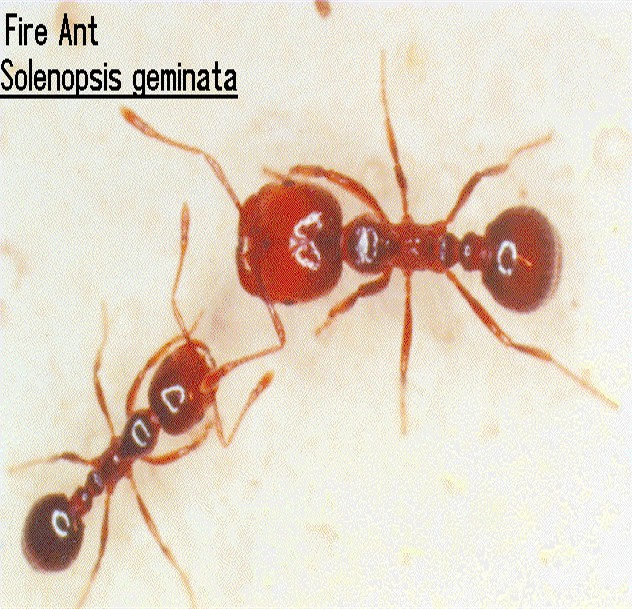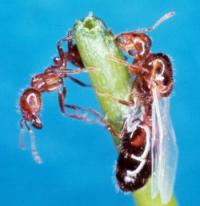
Puzzled
by Your Losses?
Are Fireants Taking a Bite Out of Your Profit?
History of the Fire Ant
More than 65 years ago, the red
imported fire ant, Solenopsis invicta Buren,
was accidentally brought into Mobile, Alaba ma from South America. It
now infests more than 275 million acres comprising most of nine southeastern
states and Puerto Rico with small infestations in Tennessee, Oklahoma,
New Mexico and California. Another species, the black imported fire ant, Solenopsis
richteri Forel, was also introduced, but the range of this species
remains limited to northeastern Mississippi, northwestern Alabama and
southern Tennessee. A large population of hybrid fire ants (S. richteri x S.
invicta) exist in a band between the two parent species and can
be found in southeastern Tennessee, northwestern Georgia, South
Carolina, North Carolina, northern Alabama,
and northern Mississippi. Fire ants can travel long distances when newly-mated
queens land on cars, trucks or trains or when winged forms are carried
by the wind. Shipments of nursery stock or soil from an infested area
may relocate entire colonies or nests.
ma from South America. It
now infests more than 275 million acres comprising most of nine southeastern
states and Puerto Rico with small infestations in Tennessee, Oklahoma,
New Mexico and California. Another species, the black imported fire ant, Solenopsis
richteri Forel, was also introduced, but the range of this species
remains limited to northeastern Mississippi, northwestern Alabama and
southern Tennessee. A large population of hybrid fire ants (S. richteri x S.
invicta) exist in a band between the two parent species and can
be found in southeastern Tennessee, northwestern Georgia, South
Carolina, North Carolina, northern Alabama,
and northern Mississippi. Fire ants can travel long distances when newly-mated
queens land on cars, trucks or trains or when winged forms are carried
by the wind. Shipments of nursery stock or soil from an infested area
may relocate entire colonies or nests.
Castes
Fire ants are social insects and unlike many insect pests, they are very organized. Red imported fire ant colonies consist of the brood and several types (castes) of adults. The whitish objects often found at the tops of the mounds are actually the ant’s developmental stages—the eggs, larvae and pupae. Types of adults are:
| 1 | winged males (distinguished from the females by their smaller heads); |
| 2 | red-brown (RIFA) or black or dark brown (BIFA and HIFA) winged females; |
| 3 | one or more queens (wingless, mated females); and |
| 4 | workers |

Newly Mated Queen
The winged forms, or reproductives, live in the mound until their mating flight, which usually occurs in the late morning and afternoon soon after a rainy period. Mating flights are most common in spring and fall. Males die soon after mating, while the fertilized queen lands and walks around to find a suitable nesting site, sheds her wings, and begins digging a chamber in which to start a new colony. Sometimes, several queens can be found within a single nesting site.
A newly-mated
queen lays about a dozen eggs. When they hatch 7 to 10 days later, the
larvae are fed by the queen. These larvae will develop into small worker
ants that will feed the queen and her subsequent offspring. Later on,
a queen fed by worker ants can lay from 800 to 1,000 eggs per day if
needed. Larvae develop in 6 to 10 days and then pupate. Adults emerge
9 to 15 days later. The average colony contains 100,000 to245,000 workers
and up to several hundred winged forms and queens. Queen ants can live
7 years or more, while worker ants generally live about 5 weeks, although
large workers can survive much longer.
In addition to hybrid imported fire ants, there are two
kinds of red imported fire ant colonies—the single
queen and multiple queen forms. Workers in single queen
colonies are territorial. Workers from multiple queen colonies
move freely from one mound to another, which has resulted in a dramatic increase
in the number of mounds per acre. Areas infested with single queen colonies
contain 40 to 150 mounds per acre (rarely more than 7 million ants per acre).
In areas with multiple queen colonies, there may be 200 or more mounds and
40 million ants per acre.